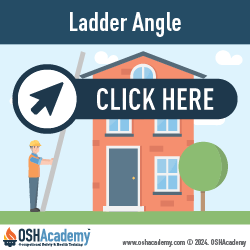Ladder Angle
Non-self-supporting ladders should have a set-up angle of about 75 degrees to the horizon unless instructed otherwise by the ladder manufacturer. When set at this angle, you will have a 4-to-1 ratio of the ladder's working length to the setback distance. The working length is the portion of the ladder from the ladders base to the upper-support point.
Here's how to do it: Stand at the base of the ladder with your toes touching the rails. Extend your arms straight out in front of you. If the tips of your finger just touch the rung nearest your shoulder level, the angle of your ladder has a 4:1 ratio.
Important Consideration: When your upper-support surface is an eave or other surface that projects out from the primary vertical surface, the 4-to-1 setback distance must be calculated from directly below the upper-support point, not from the recessed vertical surface.
The National Institute for Occupational Safety and Health (NIOSH) has developed an easy-to-use interactive ladder safety application for smart phones. The NIOSH Ladder Safety application features a multimodal indicator, which uses visual and sound signals to assist the user in positioning an extension ladder at an optimal angle. The application provides graphic-oriented interactive reference materials, safety guidelines and checklists for extension ladder selection, inspection, accessorizing, and use. The application is intended to help a wide range of ladder users, employers, and safety professionals, with their ladder-related safety needs.
Knowledge Check Choose the best answer for the question.
2-6. Non-self-supporting ladders should have a set-up angle of _____ to the horizon.
You forgot to answer the question!

